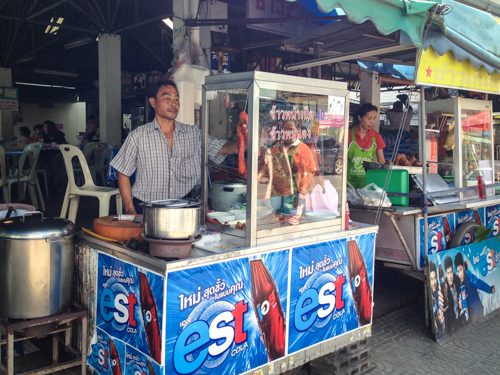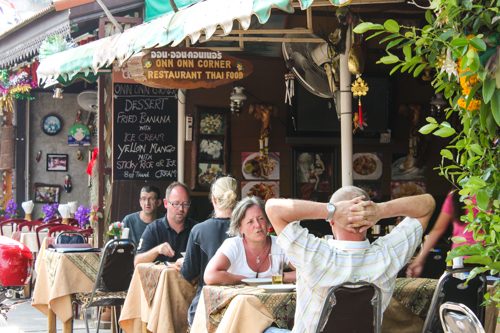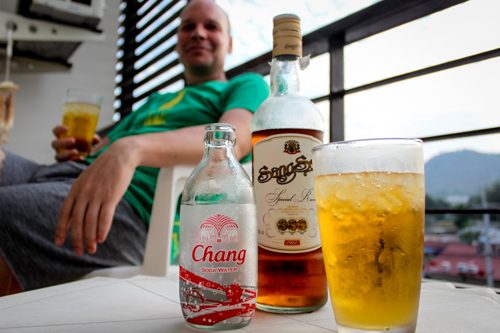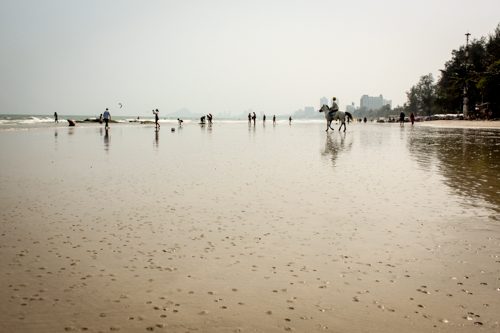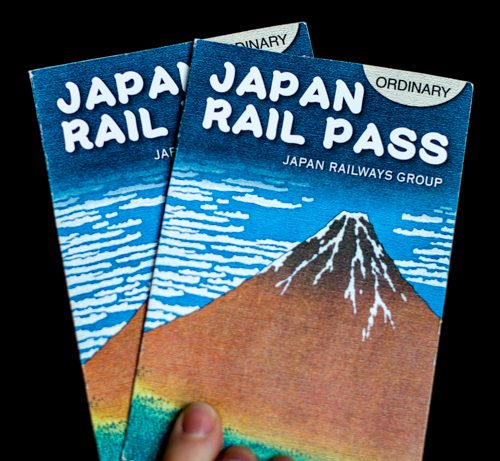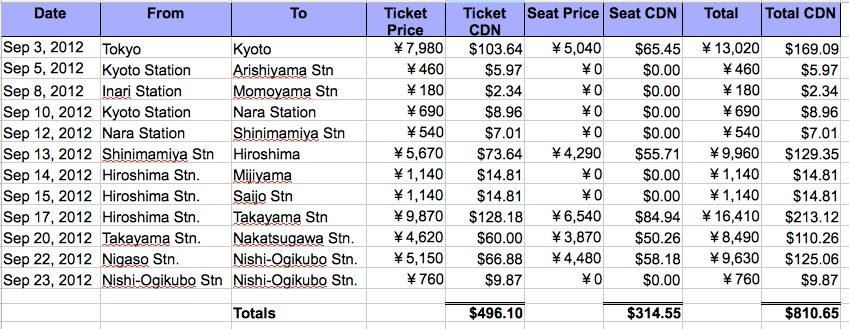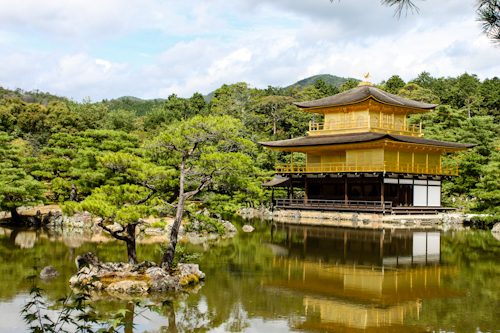Budget
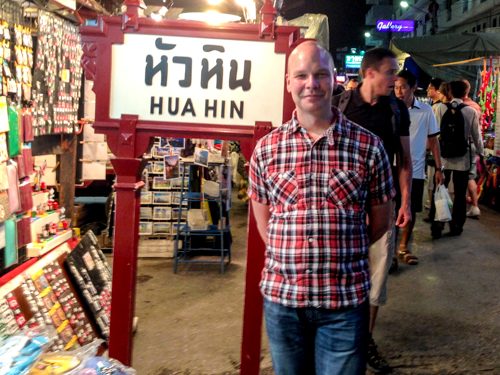 Hua Hin is heralded as the perfect spot for a quick beach holiday. Only two (or so) hours from Bangkok it certainly is easy to get to but, as a weekend get-a-way spot for wealthy Bangkokians would it fit our teeny-tiny budget?
Hua Hin is heralded as the perfect spot for a quick beach holiday. Only two (or so) hours from Bangkok it certainly is easy to get to but, as a weekend get-a-way spot for wealthy Bangkokians would it fit our teeny-tiny budget?
It’s true, the expensive, brand name, hotels and resorts (think Sofitel, Hilton, Grand Centara) dominate the coast line with their high-rise buildings, swimming pools, beautiful grounds, and world class restaurants but there is more to Hua Hin than that and we were determined to find it.
Sleeping
As we had a week to spend, and a desire to settle in a bit and call somewhere ‘home’, I set to looking for an apartment. It wasn’t difficult. Wimdu has a great selection of units throughout the city at all price points. The booking process was super simple; I just entered in Hua Hin as the destination, selected the dates I needed, and browsed the selection of available apartments. Pictures, detailed descriptions, map locations, and prices were all right there to help me choose. If I had any questions, or wanted to confirm dates, I could simply message the owner directly. With discounts given for weekly, and monthly, rentals it soon becomes clear that slow travel is the more affordable way to go.
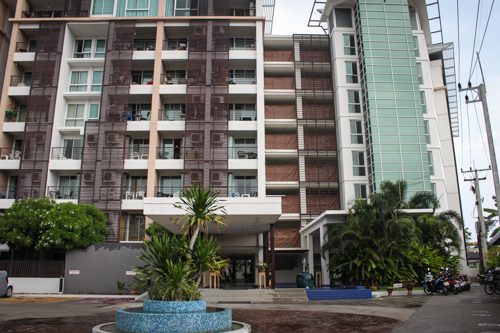 We ended up in a lovely studio apartment, away from the beach but near many eateries and the night market. With our own, albeit small and without a stove (can it really be called a kitchen then?), kitchen we can prepare morning coffee and breakfast at our leisure, keep our beer cold, and enjoy afternoon cocktails on the patio. Perfect.
We ended up in a lovely studio apartment, away from the beach but near many eateries and the night market. With our own, albeit small and without a stove (can it really be called a kitchen then?), kitchen we can prepare morning coffee and breakfast at our leisure, keep our beer cold, and enjoy afternoon cocktails on the patio. Perfect.
At about $43/night, with the weekly discount, it would be a great deal (although certainly not the cheapest room available in town – you can stay in hostels and boarding house rooms for much cheaper) but Wimdu (and most apartment rental sites) add a service fee to the bill which raised the cost to $50/night. I hate service fees. I guess if our stay was a month, or longer, then the service fee is amortized over a longer period which would lessen the impact but to those of us looking to apartments for shorter term accommodation the service fee just sucks.
Eating
Hua Hin is a tourist town so there are plenty of places to grab a bite at all price points. From hotel restaurants to seafood houses on stilts, beach front dining to night market fare, and the ubiquitous mobile stands around town, there is surely something for everyone! We’re on a budget so we kept it pretty low key; breakfast in our apartment (we buy yogurt from 7/11 and fruit from various vendors), noodle soup from the corner for lunch, and most often dinner at the night market.
Here are some of our favorite places:
From carts all over. Noodle soup with pork. 20 baht (about 70 cents). This is a lunch time staple.
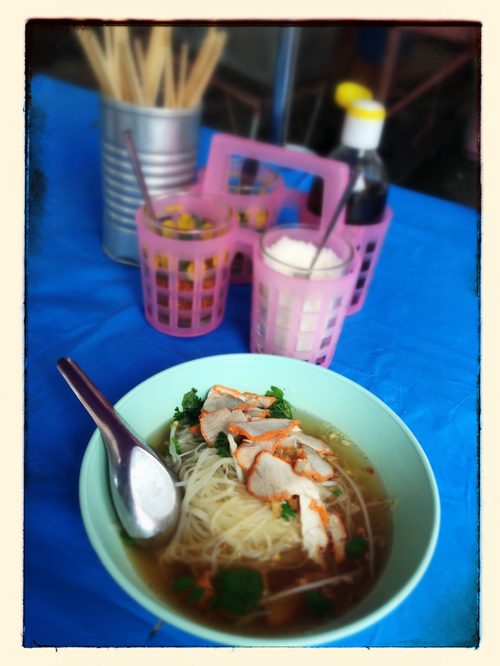 Chomsin Food Stalls; on the corner of Th Chomsin and Th Naebkhardt. BBQ duck and pork over rice and papaya salad + 1 beer. 160 baht ($5.35).
Chomsin Food Stalls; on the corner of Th Chomsin and Th Naebkhardt. BBQ duck and pork over rice and papaya salad + 1 beer. 160 baht ($5.35).
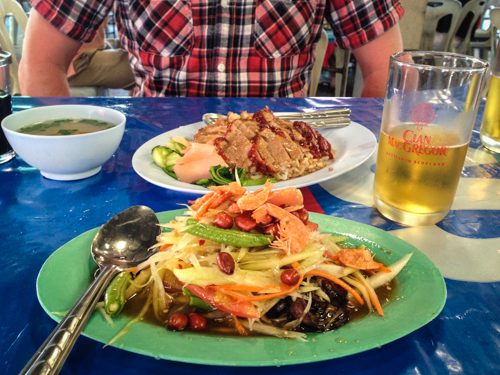 Night Market; Th Dechanuchit from 5pm onward. Moo Seafood right in front of the 7/11 was our favorite – the places more ‘in’ the market were more expensive. Stay away from the lobster and large prawns and it’s actually very affordable. Wild boar curry, snapper with ginger, and steamed rice + 2 beer. 380 baht ($12.70). The best we had here was the prawns with cashews and squid with thai curry – about the same price but unbelievably good (no pictures that day).
Night Market; Th Dechanuchit from 5pm onward. Moo Seafood right in front of the 7/11 was our favorite – the places more ‘in’ the market were more expensive. Stay away from the lobster and large prawns and it’s actually very affordable. Wild boar curry, snapper with ginger, and steamed rice + 2 beer. 380 baht ($12.70). The best we had here was the prawns with cashews and squid with thai curry – about the same price but unbelievably good (no pictures that day).
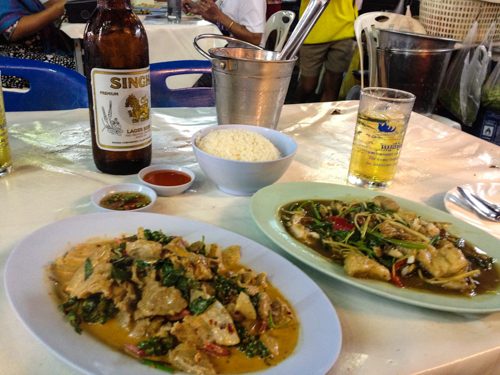 Onn Onn Corner Restaurant. For more of a ‘sit down’ experience; the food here was excellent and the prices very reasonable.
Onn Onn Corner Restaurant. For more of a ‘sit down’ experience; the food here was excellent and the prices very reasonable.
Drinking
Is this where I confess how much we actually drink? Well, let’s just say that it’s very affordable to quaff one or two here in Thailand. A large Singha beer from the 7/11 costs 42 baht ($1.40) and when out for lunch or dinner we’re paying somewhere around 80-100 baht ($2.70 – $3.30).
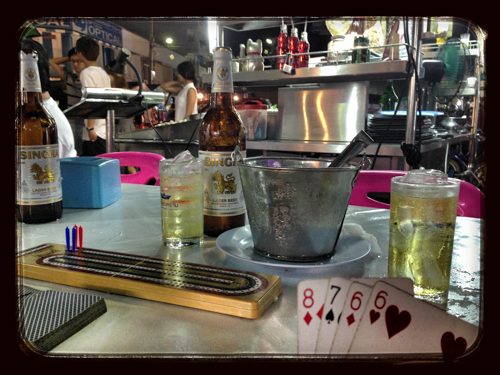 We like to have a cocktail in the evening and have taken quite nicely to the local SangSom and soda concoction. A bottle of SangSom is 250 baht ($8.40), and soda and ice can be had at the 7/11 for pennies.
We like to have a cocktail in the evening and have taken quite nicely to the local SangSom and soda concoction. A bottle of SangSom is 250 baht ($8.40), and soda and ice can be had at the 7/11 for pennies.
Beach
This is kind of where it all falls down for me. The beach just isn’t that great. North of the pier the beach is hemmed in by the concrete wall demarking the city; the beach looks desolate and uninviting. South of town, skulking in the shadow of the behemoth Hilton Hotel, it is patterned with beach chairs and umbrellas almost as far as you can see. There are a few open spaces to spread out a towel but the sand is coarse and the surroundings not exactly inviting. I usually love the juxtaposition of city and beach but here it seems all too separate; the beach is for the foreigners and the city is for the Thais. It’s a shame.
Getting Around
The city center is small enough to walk around, if you’re staying in the city. If you’re not then I’m guessing you’re at one of the resorts and maybe have no reason to leave?
If you want to go further afield there are plenty of taxis, tuk-tuks, moto-taxis, and Songthaews to get where you need to. We love the freedom of having our own moto-bike. You can rent a scooter for about 200 baht ($6.70) for the day. The roads here are quite busy so it’s not a beginner move but if you’re comfortable riding a moto-bike in Thai traffic it’s a great way to get around.
For me, Hua Hin didn’t deliver what I was looking for. It lacks the charm and laid back attitude that other beach towns possess and, quite frankly, was filled with retirees or those looking for a place to retire (now I know that at 45 I’m no spring chicken but I was positively a baby in this town!). Next time I will take the time to head farther south.
Train travel in Japan is a treat. Not only do they leave exactly on time but they are quiet, super clean, and comfortable. The extensive network of train tracks links in nicely with an even more extensive network of subway, bus and ferry routes that make it really easy to get pretty much anywhere in the country.
It’s not cheap though.
Luckily the largest rail consortium in the country, JR Rail, offers a pass that can make it significantly more budget friendly.
Getting, and using, a JR Rail Pass is easy. The JR Rail Pass website has everything that you need to know; who is eligible for a pass, how and where to get a pass voucher, pass types and prices, how and where to exchange your voucher for a pass, and how to use the rail system. We found using the pass, and getting around, to be fairly easy. A quick note about the type of pass; don’t bother paying the premium for the Green Pass. We found the Ordinary cars to be more than comfortable and, from looking through the windows, couldn’t actually see how the Green cars were any different!
Is a JR Rail Pass worth it? Well, I’m not entirely convinced that it saved us money.
As we were in Japan for 27 days, and planned to travel around the country for about two and half weeks in between our stays in Tokyo, we opted for the 21 day pass. This cost us $749 CDN each; a good chunk of change out of our budget! (All numbers here are for one person.)
I, of course, tracked every train trip we took as I wanted to see if the pass would pay for itself.
And here’s where I start to doubt whether the pass was worth it.
A ticket on a JR Rail train is a ticket to get on the train; it doesn’t guarantee you a seat. On any train there are ‘Reserved Seat’ cars and ‘Unreserved Seat’ cars. I tracked what it would have cost us just for the train ticket and what the seat reservation cost us.
For the trips we took, the total for ticket cost plus seat reservation was $810.65. The JR Rail Pass cost us $749 so it appears that we saved $61.55.
However I don’t think we needed to reserve seats for every trip we took. We always reserved seats (where possible) because it was a service included in the JR Rail Pass but, most often the ‘Unreserved Seat’ cars we more than half empty and we could have easily found a seat without ‘paying’ the seat reservation fee.
So, if I look at just the ticket price ($496.10) versus the cost of the pass ($749), it appears we lost $252.90!! Each!
To be fair; there were a couple of trips where it might have been difficult and anxiety inducing to find a seat. We travelled on one long weekend that had increased train traveller traffic and on another day something must have gone wrong as a number of trains coming from one direction were significantly late which set most of the travelling public into a tizzy but that we didn’t have to worry about because we had a guaranteed seat.
Why did we not see significant value in the pass and what can you do to ensure it’s worth your money?
We traveled quite slowly; activating our passes in Tokyo to travel to Kyoto and then stayed there for a week. We stayed 3, 4, or 5 days in all of the other destinations we traveled to. The JR Rail Pass is best for those who will be traveling significantly during the time the pass is activated.
If you are considering getting a pass, take a close look at your itinerary – if you will be moving often during the duration of your pass, then it will likely be worth it.
In the end I can’t say we shouldn’t have gotten a pass. Having the pass made it fast and easy to access and use the train system. We never quibbled over whether we would go somewhere based on the cost of the train to get there and we always knew that we would have a seat. Peace of mind and ease of use trump the few dollars we may or may not have saved in the long run.
**Click Here to see Travel To Japan: What Does It Cost (Part One)**
There is no doubt that Japan is an expensive country to travel in. Our travel to Japan was, in fact, the most expensive trip we’ve ever done.
It was also the best trip we’ve ever had. It changed our lives; it was here, during this trip, that we finally decided to take the next GiantStep to leave Canada. It was worth every single yen.
We broke our expenses down into five basic categories:
Accommodation
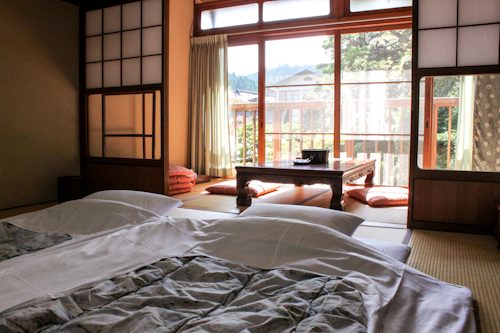 This wasn’t a backpacker trip so I wasn’t necessarily looking for the cheapest option but I was cognizant of price and wanted to get the best I could for the money I was willing to spend.
This wasn’t a backpacker trip so I wasn’t necessarily looking for the cheapest option but I was cognizant of price and wanted to get the best I could for the money I was willing to spend.
We stayed in a mix of accommodation styles; apartments, Tokyo hotels, guesthouses, traditional ryokans, local minshukus and even a temple. I placed links in the spreadsheet next to each entry – I recommend every place we stayed. Some were very reasonably priced (an apartment in Tokyo for $100/night!) and some were very expensive ($300 for a ryokan stay…but it included an amazing dinner and breakfast).
On average we spent $123.80 per night. If I factor out the meal costs of the two most expensive stays (that included meals), the average drops to $112.88; we would be hard pressed to travel in our own country for this cost!
Transportation
 Flights and trains were the big budget items here.
Flights and trains were the big budget items here.
Our flights from Calgary to Tokyo (return ticket) cost $3128.24 – that’s quite the chunk of change out of a budget! I’m glad we were able to spend a month in Japan because I would be hard pressed to think that paying that kind of money for a two week holiday would be worth it.
The three week JR Rail passes were the next biggest transportation expense at $749 each – $1498 for the two of us! They turned out to be worth it – although just barely.
We spend just over $400 on other non-JR train tickets, subway rides, bicycle rentals, and the occasional taxi.
Food and Drink
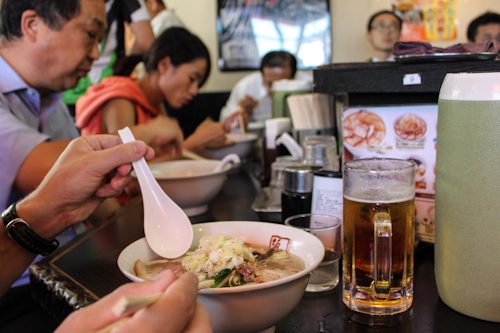 There really is nothing Jason and I enjoy more than spending time over a meal, or whiling away an afternoon in a pub so it’s no surprise that our food and drink costs were high.
There really is nothing Jason and I enjoy more than spending time over a meal, or whiling away an afternoon in a pub so it’s no surprise that our food and drink costs were high.
We stayed in apartments for half our trip so were able to self cater breakfast most of the time. We love spending our mornings lounging around, catching up on the interwebs, drinking coffee, and snacking on whatever we could find at the grocery store so apartments fit the bill nicely. It turns out that going out for coffee in Japan is an expensive affair, sometimes costing as much as $5 per cup for regular coffee so making it at ‘home’ was very budget friendly!
After a day of sightseeing we usually head back to our room to enjoy an early evening cocktail before dinner. Alcohol is fairly inexpensive and widely available in shops so we could just pick something up on our way. Going out for a drink, however, can be fairly pricey; probably no more expensive than the places we frequent here in Calgary, although Japanese beer is a little lacklustre and, at home, we don’t go out every night.
We really didn’t think too much about the budget when looking for a place to eat. We tend to enjoy middle-of-the-road establishments and knew there was room in our budget to accommodate what we like so we weren’t out to find the cheapest meal at any point. A few times, when in particular areas that were known for a certain meal, we would splurge but mostly we stuck to ramen houses, kaiten (conveyor belt) sushi shops, and izakayas (pubs). A few times we picked up some sushi from the grocery store but that was more about wanting to stay home than worrying about the budget.
We almost always had a drink (or two, or three) with a meal; these are not broken out in the budget sheet but you could probably half all the costs there to determine a non drinking budget – often our booze bill the same as the food bill. Definitely would be much cheaper to travel as a tee-totaller but it’s just not our style.
On average we spent $105.58 per day on food and drink.
Attractions/Activities
We went to Japan to be in Japan. It was a tiny expat experiment whereby I wanted to really pretend that I lived there. Sure, we visited temples and shrines, took a tour and a cooking class, and revelled in the Sumo Grand Championship, but what I really enjoyed was just riding the trains, going for dinner, cruising the grocery store aisles, and wandering around the streets imagining that this neighbourhood was my neighbourhood.
I think our attractions/activities costs are fairly low at an average of $20/day.
Miscellaneous
Miscellaneous holds all the other stuff. We needed some toothpaste. We did laundry once. Luckily, we are not souvenir people so this category usually stays quite low. In fact most of this category is taken up by the pocket wifi device we rented to stay connected the whole time.
We traveled through Japan for 27 days. It cost us $11,965.52 – I had budgeted $12,000 so I’m happy to be under budget.
Here is the entire OneGiantStep Japan Budget should you care to see more of a breakdown.
Our trip to Japan was everything I wanted it to be, and more. It was worth every single penny.
During our RTW trip we tracked every sole, peso, riel, lira, euro, dinar, rupee, baht, kip, dong, ringgit and rupiah mostly out of necessity as we were on a backpacker budget and needed to know exactly what we had spent and exactly what we had left – even if it took us forever to figure out the conversion!
This time, as we travel to Japan, we’re going to track every yen because yes, we still have a budget. Granted, it is not a backpacker budget this time, but it is a budget all the same.
I also want to make our budget public because, once again, finding information about how much it costs to travel in a place is difficult to come by. It is getting better; there is more information out there about what people are spending but it always helps to contribute to the knowledge pool. So, just like last time, we’ll be posting our budget spreadsheet when we get home.
Sometimes coming up with a tracking spreadsheet can be daunting. I like to keep it simple then I’m more apt to actually use it rather than being overwhelmed by it. Here what we’ll be tracking:
- Date – this will give us a sense of per day costs although many items are amortized over the entire trip (flight costs for example).
- Type – there are five categories; accommodation, transportation, attractions, food&drink, and miscellaneous.
- JPY Cost – if we pay for an item in Japanese Yen then we’ll show that cost in this column.
- CDN Cost – here we’ve taken an average conversion of 77 JPY per CDN dollar – the conversion will vary but this should serve our purposes. Some items we have already paid for with our credit card and were charged straight to CDN dollar so there is no JPY noted.
- Comments – here is where we’ll detail what the item actually is. This will help us further break down the categories and remind us exactly what we paid for.
We’ll keep a notebook with us and just quickly jot down our expenses as they happen and enter it into the spreadsheet when we get a chance. It’s really not that onerous at all. Here’s a screen shot of how simple the spreadsheet really is:
Notice something? Yep, we’ve spent just over $7000 and we haven’t left yet!! Japan is going to be expensive.
Wait a minute though – a lot of those expenses are in-country expenses, meaning we have paid them up front so we won’t have to pay once we’re there. It includes flights and train tickets (gulp…that was expensive…but I’ll give a full report as to whether the JR Rail passes were worth it. I hear they are more than worth it so we’ll see.) as well as tickets to the Grand Sumo Tournament in Tokyo. SUMO, people!!
It also means that 20 nights of accommodation are already paid for. We’ll only have to pay up for about a weeks worth while we’re there. Granted, some of those nights are some of the most expensive nights there. Staying in ryokans and temples is hard on the wallet but should be priceless in terms of experience.
This is most definitely NOT a backpacker budget but we weren’t planning on a backpacker trip this time. This is why we dropped Japan from our RTW itinerary…so we could come home, save, and go when we could afford to do it how we want to.
Stay tuned to see how much the whole trip costs us!
**Click Here to see Travel To Japan: What Does It Cost (Part Two)**
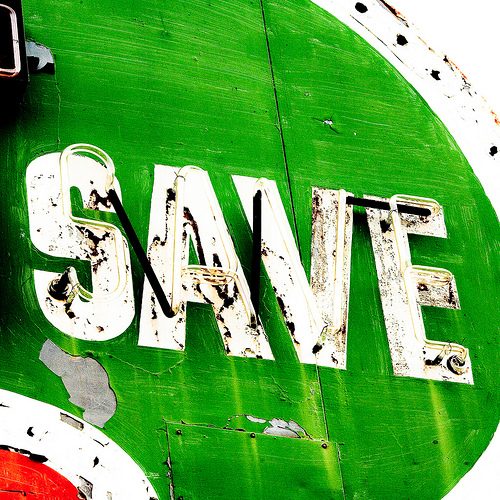 You know that I don’t think it’s ‘luck’ that allows a person to travel. I think you have to have your eye on the prize, be willing to make sacrifices, and save, save, save!
You know that I don’t think it’s ‘luck’ that allows a person to travel. I think you have to have your eye on the prize, be willing to make sacrifices, and save, save, save!
Travel doesn’t have to be expensive; and saving for travel doesn’t have to be painful.
The cost of a trip varies greatly depending on where you want to go. Europe is notoriously expensive but I’ve heard that bargains can be found in northern Italy and Spain. We found Vietnam and Laos to be as cheap as legend says they are but we’re expecting Japan to cost us a pretty penny.
Overall, long term travel is cheaper than short term vacations. Distances between even major destinations are much shorter than traveling from ‘home’ and back every time. Local air carriers can be used and even ground transportation is possible. Mindset is different for long term travel also; without the need to do it all while you’re on vacation, you can relax and take things at a slower, less expensive, pace.
Figuring out a budget can be the hardest part but there is plenty of information out there now to help you figure out a typical budget:
Warren and Betsy of Married With Luggage run the RTW Expenses site solely to provide information on what it has cost them to travel long term.
Lauren of Never Ending Footsteps also posts a monthly summary of her finances on the road. Mostly Asia so far but I know she has recently been in Europe and is currently in Africa!
Jeremy of Living The Dream has a detailed account of every dime he spent while traveling. With lots of Asia and Europe in his travel resume he gives some great balance to the budget.
The Aussie Nomad focuses on Europe in this series of daily budget posts.
There is often plenty of information on Europe and Asia whereas South America and Africa budget posts are harder to come by. Simon and Erin have a great round up from their time in South America.
I also have budget series from our RTW trip as well as a detailed spreadsheet of what we spent in the 14 countries we visited. I’m planning the same kind of detail for Japan; I’ll be sure to post it once we’re back!
It’s important, when visiting these sites, to not just read the budget posts. You need to get a sense of who is spending this money; are they uber-budget-backpackers who would happily sleep in a 13 person dorm room, or luxury travellers for whom 3 star hotels are an abomination? I always get to know the writer and make sure that they travel in a way that is comfortable for me.
Which brings up probably the most important point; be honest about how you are willing to travel. Don’t plan on a backpacker budget if that’s not really how you travel – you’ll be miserable on $25/day and will begrudge every dollar over that you spend. It doesn’t have to cost a lot to travel but it’s worth saving what you’ll need to travel happily.
Here are some of my own travel saving tips:
- Open a dedicated savings account. Name it. Our current one is called OneGiantStep Goes To Japan.
- Think about what you’re spending. Those two beers tonight? That’ll easily pay for a bungalow for a night on a Thai beach.
- Put all ‘extra’ money into the account. Pocket change, birthday money, pennies from the couch, anything extra. It all adds up.
- Get a side job . Paper route? Barista? Slinging beers? Freelance writing? Whatever talent you have – pimp it!
- Connect to the saving. Keep that trip forefront in your mind – post pictures, use screensavers, read articles/blogs- it’s easier to save if you are always thinking of the end goal.
- Know how much it’s going to cost. You have to know the goal!
- Sell stuff. What is in that spare room anyway? Do you really need that second set of golf clubs? What about that pile of books? That snowboard you didn’t use at all last year?
- Keep track of what you make AND what you spend NOW, before you go. It’s much easier to keep track of what you’re spending while travelling if you’re in the habit of doing it before you leave. We’ve traditionally used spreadsheets for this but recently have started using Mint.com – it’s integrated with your banking and credit cards to help track and categorize spending. You can set budgets with it and know if you’re overspending in a certain area – it’s a great tool to get a handle on where all those dollars are actually going as opposed to where you think they’re going.And don’t forget about the free tax software that’s available too – remember, every penny counts!!
If you plan properly and honestly, put some effort into saving, and sacrifice just once in a while, you too can be ‘lucky’ in travel!
Share your saving-for-travel tips below…how are you getting lucky?
Photo Credit: Thomas Hawk
So you’ve saved and saved and saved, put away your refund determined by a tax estimator, and now it’s finally time to hit the road. How are you going to manage that wad of cash while you’re away? The more thought and planning that you put into this before you leave, the easier it will all go while you’re on the road.
Managing The Bank Accounts
We used a two tiered bank account system:
- Our primary savings account was with a brick and mortar bank in our home town. This account was the highest interest savings account we could find so that we could maximize the money our money was making for us while we were away.
- Our daily use account was with an on-line bank that offered free ATM withdrawals in foreign countries. We kept at most $2000 at a time in this account and, as it depleted, we would transfer money to it from the primary savings account. We set this account up as a ‘bill payment’ on the primary account and would simply electronically pay the bill to fill up the account.
Debit Cards
Our main method of obtaining cash while we were away was ATM’s. We had barely any trouble finding bank machines everywhere we went. Every major city or town has at least one. If we were heading somewhere very small we would make sure we had taken enough out already. Even Laos, which by all accounts had a dearth of ATM’s, had more than enough to make access easy.
Depending on the local ATM fees (remember, our bank account didn’t charge any ATM fees but sometimes the local machine itself does), we would take out enough money to last a couple of days. Cash is king on the road so this meant we always had to have enough to cover transport, hotel, food, drink and entertainment.
Have a back up!!! We carried two ATM cards each for our daily bank account and an additional ATM card each for the savings account. We never kept all of these in the same place for obvious reasons.
The need for this became abundantly clear on the day that the ATM machine in Nha Trang, Vietnam munched on Jason’s’ card. We watched in horror as it repeatedly didn’t spit it out all the way and kept sucking it back in…and then it stopped trying and just kept it. Bummer.
Credit Cards
We used credit cards only for airline tickets and to secure reservations (if needed). The interest charged on credit cards is outrageous and so we paid the balance as soon as possible from our savings account. We used credit cards only for the convenience of them…it’s hard to pay for an online airline ticket with cash!
Ca$h Is King!
Cash ruled the world everywhere we went. Most places don’t take credit cards never mind debit cards and, even if they do, they likely charge more for the privilege (it costs them so they pass the cost on to you).
Never accept torn, ripped, dirty or wrinkled bills…if you do you are being used as a dumping ground for these bills. Merchants will often refuse bills that are torn, ripped, dirty or wrinkled too much so you shouldn’t accept them either.
Back Up To The Back Up
We carried $500US cash in our bags as the ultimate backup. We had heard that some visas and entry fees could only be paid in US cash (and found that to be true) so we brought this along for those occasions. We made sure that the bank issued us crisp, clean, unmarked, whole bills and kept them in that state as we travelled. Once in a while we found an ATM that dispensed US dollars (I have no idea why) and so we would top up this fund at that time, although the original $500 would have gotten us through.
Currency Exchange
Try to limit the cash you need to exchange at a border crossing – you will most definitely get ripped off. Not only is it a bad exchange rate but we found that sheisters tried (and succeeded) in confusing us by talking quickly, quoting exchange rates from one currency to American dollars and then into the second currency, and pushing to have the transaction take place quickly. More than once we walked away thinking ‘hey, wait a minute’…but it was done. We instituted a policy that we both had to understand and agree to the math before we made an exchange. If you want to get ahead of the game, click here to order your foreign currency before you get to your destination. That way you can avoid being ripped off!
Keep Track Of Every Dime
Always know the state of the budget. It’s fine to be over (and even better to be under!) but you should know where it’s going and have some idea whether you can make it up or not. The last thing you want is to run out of money before you run out of time!!
I set up a spreadsheet before we left that tracked all the money in about 6 categories (you can check it out here). We had a budget notebook with us all the time and would simply write down all the money we spent. Every couple of days I would update the spreadsheet – I had already set it all up to do the math so could keep track of it all very easily.
 I know it’s dry, and terribly boring, but if you don’t pay attention to your money before you leave you may end up worrying about it more than you need to while you’re away.
I know it’s dry, and terribly boring, but if you don’t pay attention to your money before you leave you may end up worrying about it more than you need to while you’re away.
Save…Save…Save!
I know this sounds like a no-brainer…and it is…the more money you can put away the better off you will be on the road. No-one likes to worry about how much they have, or how much they are burning through so the more you can save the better.
First off…stop digging the hole! Stop accumulating whatever debt you are accumulating. No more ‘pay-as-you-go’, no more ‘don’t-pay-until-next-year’, no more ‘just-put-it-on-the-credit-card’. Just. Stop.
Then, work towards filling the hole. Pay off debts aggressively. Debt is costing you money and giving no reward. Once the debt is gone, all that money spent paying it off is now building the pile ‘o money that will be yours!
We made plenty of sacrifices so that we would have enough for our trip. We tracked all our spending so we would know where every dollar was going (a habit we keep to this day) and we increased our consciousness about spending money, asking ourselves whether we really needed an item or just really wanted it. Every purchase was compared to ‘how many days in Thailand’ it cost. It really worked and constantly reminded us of the bigger goal that we had.
We ate out at restaurants way less often (one of our fave things to do), we didn’t go on any mountain biking trips that year, didn’t buy any new clothes and moved into a cheap rental once we had sold our condo.
Any money that didn’t need to be spent, wasn’t. Eye on the prize baby!
Find A Good Bank That Will Help You
I know, sounds impossible, but some are better than others and, if you do your homework you might find one that is better. It’s worth the time to look.
Banking fees were a significant portion of our budget…about 2%…so it was important to make sure we were getting what we needed and spending the least amount to get it.
Our primary concerns were:
- Account Security. We had a pool of money that would gradually diminish as the year went on but we didn’t want it all to be accessible at once for security reasons. What if someone got hold of our cards and could gain access to the whole pile? So we set up a system of bank accounts to which our cards only had access to one. We were able to electronically transfer money to keep this one account filled up as we needed. Alternately you could schedule payments from one account to another.
- Banking Fees. We wanted an account the would give us the greatest interest rate but the lowest banking fees…no point spending money to store your money! Many accounts waive fees if you have a certain amount in them all the time. Seeing as we had enough money to cover this minimum we managed to reduce our fees significantly.
- ATM Fees. Our plan was to use ATMs almost exclusively to access cash so we needed a plan that would minimize these costs. Some banks charge up to $5 per transaction at a foreign ATM machine…and that’s on top of the local fee that the ATM machine may charge! Many ATMs have a daily limit that you can withdraw and so we would have to make multiple withdrawals to have enough cash…and would be charged for every withdrawal. Ouch! We managed to find a bank that charged zero ATM fees, foreign or otherwise. Score!!
- Credit Cards. You need a big name card. Visa or Mastercard are where it’s at in the rest of the world. Actually, ca$h is king, but if you’re going to carry a credit card (and you should) then it should be one of these two. Find one with the lowest interest rate possible and beware of exchange rate premiums that may apply. Read the fine print…out of country rules may be different than in country rules.A credit card with a reward or travel points system may actually help pay for your travels! Look into the possibilities.
Don’t be afraid to change banking providers if you find that your current bank can’t (or won’t) help you. Our long term bank was absolutely inflexible with regard to fees etc. We had evidence of another bank that would be able to help us, but they still could not bring enough to the table to make us stay.
Don’t negate on-line banks. Our end case scenario involved a ‘brick and mortar’ bank that had an on-line affiliated bank. The combination of the two met all our above needs and worked like a dream.
Remember it’s your money!!
Power Of Attorney
Ugh! It just gets drier and boring-er, doesn’t it? But this piece is what gave us the most piece of mind.
Sure, we thought we had accounted for every financial scenario, had dotted all our i’s and crossed all our t’s…but what if we forgot something? How were we going to manage it while we were on the other side of the world? We asked someone to be our Power Of Attorney.
Some considerations:
- Choose someone you absolutely trust. Remember, they will have access to your money. Whether it’s a family member or a friend, it has to be someone that absolutely has your best interests at heart.
- Check with your bank as to how this is done. It may be as simple as you writing a letter or, as in our case, you may need to all head to the bank to have paperwork signed.
- Learn the conditions of the PoA. Ours allowed our friend to deposit money, withdraw money and write cheques on one account but did not allow access to all the accounts or the investments. This protects everyone involved.
We ended up using our Power of Attorney more than we thought we would. A couple of unexpected bills showed up that he could take care of for us and, while arranging to come home, he took care of the rental deposit etc so we could have a place to live. Thanks Ron!!
It’s about more than saving money…it’s about managing your money.
Are there any other things you have done to financially prepare for a big trip?
That’s the big number. What it cost for us to put our jobs on hold, sell our home and car, say goodbye to friends and family and travel around the world for a year (326 days to be exact). That’s under our predicted budget of $50,000 – and no I didn’t cook the numbers to make it look good! You can look at the raw numbers here.
It seems like a big number doesn’t it? But what would it have cost to stay home for the year? Let’s say a modest mortgage payment of $2000/month – that’s $24,000. Then our regular weekly spending budget of about $400 – that’s $20,800 and we’re at almost $45,000 already not including any vacations, insurance, utilities, car payments etc. Sure, we weren’t making money while we were away, but it certainly didn’t cost us a whole lot either and I got to travel around the world for a year! Seriously, why doesn’t everyone do this!
The number does not include any pre trip costs such as clothing or equipment that we bought especially for the trip, vaccinations which we also paid for pretrip, or the Spanish lessons we took to prepare ourselves for three months in South America. These costs came out of our pocket as we were planning and preparing. During this time we didn’t buy ourselves new clothes, stopped eating out as much and sacrificed more than one mountain biking trip so that we could better afford to spend the money on trip focused items. There is a ‘PreTrip Costs’ tab on the spreadsheet that shows that these items totaled just over $6500. A good chunk of change but money we would have likely spent during this time anyway.
 It does include every penny we spent after we left Canada. We carried a small notebook with us everywhere and wrote down every single item we paid for every day. It was not as onerous as it sounds and, when the only way money is flowing is ‘out’, there is incentive to track it all! We used a page per day but I have seen other travelers budget books and have marveled at the teeny tiny print they used in order to squeeze a week or more onto one page! Some even have complicated coding systems to categorize expenditures on the go.
It does include every penny we spent after we left Canada. We carried a small notebook with us everywhere and wrote down every single item we paid for every day. It was not as onerous as it sounds and, when the only way money is flowing is ‘out’, there is incentive to track it all! We used a page per day but I have seen other travelers budget books and have marveled at the teeny tiny print they used in order to squeeze a week or more onto one page! Some even have complicated coding systems to categorize expenditures on the go.
The numbers really don’t mean anything though if there is no idea how we spent the money. It’s fine to say that we averaged $21/night for accommodation in Thailand but were we sleeping in a bug-infested hut or ensconced in a 4 star hotel? I’ll try to shed some light.
Accommodation
 Accommodation varied greatly. We always had our own room (no dorm rooms) with a private bath (most of the time). We stayed in hotels, hostels, guesthouses, huts, cave rooms, boat cabins and desert camps. Sometimes it seemed like we were paying a fortune for a sh*t room (San Pedro de Atacama in Chile, or the ‘prison cell’ as we call it in Rio de Janeiro) and other times it seemed like we were getting the deal of a century (‘the beach’ room in Thailand, or the 5 star hotel in India which wasn’t cheap but compared to what we would pay for that in Canada was a steal!). I would say that we stayed in average ‘Flashpacker’ accommodation and, on average over the whole year, paid about $30 a night for a room.
Accommodation varied greatly. We always had our own room (no dorm rooms) with a private bath (most of the time). We stayed in hotels, hostels, guesthouses, huts, cave rooms, boat cabins and desert camps. Sometimes it seemed like we were paying a fortune for a sh*t room (San Pedro de Atacama in Chile, or the ‘prison cell’ as we call it in Rio de Janeiro) and other times it seemed like we were getting the deal of a century (‘the beach’ room in Thailand, or the 5 star hotel in India which wasn’t cheap but compared to what we would pay for that in Canada was a steal!). I would say that we stayed in average ‘Flashpacker’ accommodation and, on average over the whole year, paid about $30 a night for a room.
Food & Drink
 Some variety here from country to country although our eating habits stayed pretty much the same. Breakfast was often included in the room charge, or we would eat a small breakfast out. Then we would typically have one large meal in a restaurant of some sort and a smaller snack maybe from a street vendor or with a beer somewhere. We always ate local food and tried to shy away from ‘tourist’ restaurants. We would certainly have a drink with every meal (okay, not breakfast…often) and probably one or two more besides – it would be interesting to see food and drink broken out separately but, because they are so intrinsically linked for us, it became impossible to keep track. It looks like, generally, we spent more on food and drink per day than we spent on a room to sleep in. That makes sense to me because we like to eat and drink and use it as a form of entertainment.
Some variety here from country to country although our eating habits stayed pretty much the same. Breakfast was often included in the room charge, or we would eat a small breakfast out. Then we would typically have one large meal in a restaurant of some sort and a smaller snack maybe from a street vendor or with a beer somewhere. We always ate local food and tried to shy away from ‘tourist’ restaurants. We would certainly have a drink with every meal (okay, not breakfast…often) and probably one or two more besides – it would be interesting to see food and drink broken out separately but, because they are so intrinsically linked for us, it became impossible to keep track. It looks like, generally, we spent more on food and drink per day than we spent on a room to sleep in. That makes sense to me because we like to eat and drink and use it as a form of entertainment.
Ground Transport
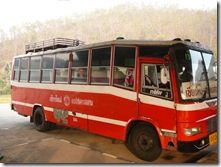 We did not take that many flights during our year – only 12 actually. We did, however, take a lot of buses, a few trains, a couple of boats and occasionally a car.
We did not take that many flights during our year – only 12 actually. We did, however, take a lot of buses, a few trains, a couple of boats and occasionally a car.
Taking public transit, buses and trains cuts down on costs dramatically. We spent a lot (and I mean a lot) of time on buses and I find them great value for money. I love travel days and we had the time to spend so they were a great option for us. We took trains in Germany and, although they were famously reliable, they were also expensive. We never did rent a car as it always seemed expensive although we did share long distance taxis in Jordan and hired a car and driver as part of a package in India.
Sightseeing
 Trying to see what we wanted to see, do what we wanted to do and being able to afford it all was a constant struggle.
Trying to see what we wanted to see, do what we wanted to do and being able to afford it all was a constant struggle.
Included in this category were any entrance fees to sites or museums, any tours we took (whether short city tours or multiday region tours), cooking courses, and bike rentals etc. Some of the longer tours were a set price including transport, room, site fees and food but we tracked the cost in just this one category.
Miscellaneous
Pretty much everything else. You know…all that other stuff that doesn’t fit in one of the definable categories. Bathroom fees, buying books, international phone cards, toiletries, tour guide tips, internet fees, ATM charges, laundry, new clothes, postage…a litany of miscellany that doesn’t fit anywhere else. Backpacker insurance was split; we paid for J’s full year and 1/2 a year for me from pre trip money, but I had to renew half way through so that came out of traveling money.
Souvenirs
We purposely did not buy too many souvenirs. I did not want to worry about carting around, or mailing home, tons of trinkets and treasures. It all looks so wonderful while on vacation but I know me and it’s very likely I won’t like whatever it is once I get it home. That’s not to say that we didn’t buy anything while away – we picked up these nice things that will always remind us of where we went:
- A beautiful woven belt from Taquile Island on Lake Titicaca in Peru.
- A kilim (carpet) from Turkey that I love as much for its story as I do for its beauty.
- A Buddhist mandala print from Nepal.
- A stunning woodcarved wall hanging from Thailand – the artistry and workmanship is amazing.
- Silk wall hangings from Lao. In the end I think maybe they are knock offs from China, but that is just part of their story.
- Two very small, but interesting, paintings from Bali.
Visas
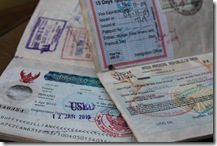 Eight of the fourteen countries we visited required visas, although only two of them required that we have one ahead of time. We had neither before we left home and so applied for, and received them, while we were on the road.
Eight of the fourteen countries we visited required visas, although only two of them required that we have one ahead of time. We had neither before we left home and so applied for, and received them, while we were on the road.
We obtained the India visa while we were in Ankara, Turkey where there is an Indian Embassy. The Brazilian one we initially tried while in Buenos Aires, Argentina but couldn’t get our sh*t together so we tried again in the border town of Iguazu Falls where the office was small and much more relaxed…they didn’t even want all of our sh*t and supplied the visa with no trouble at all…go figure.
All other visas were obtained at the border, either at the airport or the border crossing…for a fee of course. Some countries even insisted on us paying to leave…Bali charged almost as much to leave as to enter!!
Some Fun Budget Stuff
- Most expensive country. Per day costs in Brazil were the most expensive of the year. Accommodation was expensive (and crappy, except in Paraty) and food and drink were also costly.
- Cheapest country. The cheapest country per day was Vietnam and we certainly could have done it for much less even. We upped our accommodation budget to $30/night and slept in some very nice rooms but a normal room could be had for much, much less. The country is as cheap as legend says – I couldn’t believe it but it was true. One night J and I had dinner (in a restaurant not a roadside stall) and ate all the noodles and pork and springrolls we could fit in along with as much beer as we could quaff – the bill? Six dollars!! Seriously! I love Vietnam!
- Most Expensive Flight. The flight home from Bali was the most expensive. Not surprising as it was also the farthest flight.
- Least Expensive Flight. Zero dollars! That’s right…free. Our flight from Turkey to India was on Royal Jordanian Air and had a stop over in Amman, Jordan – it was free for us to stay for 10 days and continue the flight then. The flight from Singapore to Bali was also free. I don’t understand the economics of offering free flights but, yay for free!
- Most Expensive Drink. Without doubt it was the double Gin and Tonic I had to have in the New Dehli airport. Only one bar in the whole airport and it had run out of beer. I was getting on a plane!! $40…enough said.
- Totally Worth The Money.Some things are just worth the little bit of extra money (see ‘Most Expensive Drink’ above).
- Getting apartments in Santiago, Buenos Aires and Berlin was totally worth the money – we loved settling into neighborhoods, cooking meals and feeling like a local.
- Trekking the Inca Trail to Machu Picchu in Peru was totally worth it as it stands as one of the highlights of my year.
- I loved taking city tours or short term region tours as it gave me a chance to easily learn about an area and was a great chance to meet other travelers.
Balancing a budget over a year of travel when current costs are higher than expected and future costs are unknown can be a challenge. Remember that these are our numbers and that everyone travels differently. We met people who were traveling on half of what we were and know of others who spent significantly more than this for one person. Would I have liked to have had a bigger budget? Hell yeah! But at some point you have to stop saving and planning and just step out and do it!
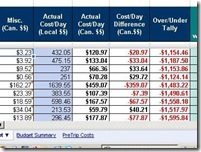 One look at the budget spreadsheet and it’s easy to see that we are over budget. Significantly over budget. So far, more than $4000 over budget and we’re only 4 months into our one year trip.
One look at the budget spreadsheet and it’s easy to see that we are over budget. Significantly over budget. So far, more than $4000 over budget and we’re only 4 months into our one year trip.
For a while it caused me quite a bit of stress. As I saw the under/overage column be in the red day after day I would worry about it more and more. What were we spending so much money on? Why were the countries that I thought would be more inexpensive so expensive? Was this going to mushroom and affect the rest of the trip?
I was getting crankier and crankier about it and wasn’t enjoying everything because I was worrying so much. Did we pay too much for such-and-such? Could we have gotten such-and-such for cheaper? Should we not have done such-and-such because it cost so much? Why did we have to pay so much for what appeared to be a nothing room with an uncomfortable bed and a shower that doesn’t work? Was I not doing a good job of finding places? Was there something more I should have been doing?
It peaked with an argument between Jason and I where I accused him of not being concerned at all with the budget while I worried about it constantly. That, of course, was not true. We just had different views on how the budget was going.
The $100/day budget we had set out was meant to be an average over the entire year, taking into account that some countries would clearly be over and others would be drastically under. While Jason understood this concept completely and accepted that the law of averages would be upheld, I, for some reason, could not let it go that we were over almost every single day.
In the end we agreed that I would relax a bit and trust that it would all average out and that Jason would be also keep an eye on the budget.
What have we learned?
- I have learned to be much more relaxed about the numbers now and to trust that it will average out. We looked at all the ‘big’ overall numbers again and realized that, even if we’re a little over budget daily, there is some room in the big budget for that.
- We learned that maybe we’re not quite the ‘budget’ travelers we thought we could be. Although our rooms now are not luxurious by any standard, we are paying a bit more for a room than we were…and we’re happier for it.
- We learning that we have to do the things that we want to on the trip. We won’t have any fun if all we do is hang around the hostel. We like to take tours and do stuff, and that costs money, so we’ll spend the money.
Maybe I’m finding it easier now because our ‘expensive country’ travel is coming to a close and I can see the day when we’ll stop bleeding money and maybe even make some of it back. I don’t know…all I know is that I’m enjoying myself more now…and so is Jason.
I struggled with the idea of making our budget public. The thought of making all of our spending open to scrutiny makes most of us squirm. However, while researching our RTW trip, I found it very difficult to get a real idea of what if might cost us and so I decided to be transparent.
It is what it is, and cost us what it cost us. Why shouldn’t I share that with others that are interested in doing the same thing. And to those of you that are just shamelessly interested in what it cost us I ask you what did you do with your salary last year?
Here’s a link to our daily budget while we are on the road. We will keep it up while we are away. Every dollar…tracked.
We have an average daily budget of $100 (Canadian) per day and will compare every day to this average.
The budget is broken up into 5 categories:
- Food And Booze
- Ground Transportation (Air transport is dealt with on the summary tab)
- Lodging
- Sightseeing
- Miscellaneous
Update: You can read our post, OneGiantStep RTW Dollar By Dollar, to see the final numbers and to understand our level of travel and where all the money went.




